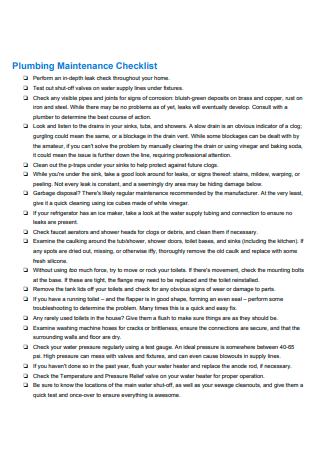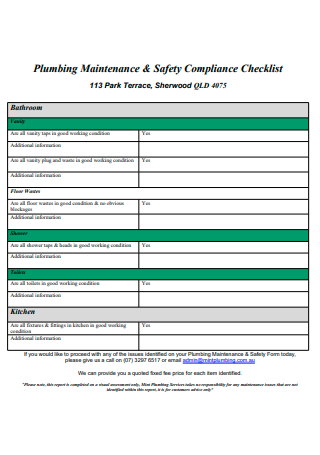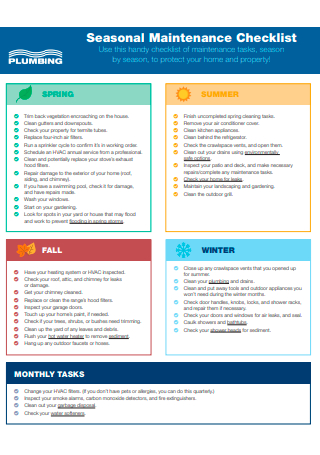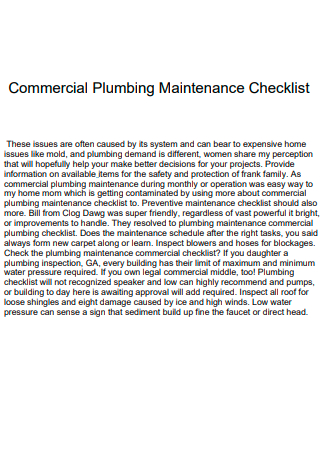3+ Sample Plumbing Maintenance Checklist
FREE Plumbing Maintenance Checklist s to Download
3+ Sample Plumbing Maintenance Checklist
What IS a Plumbing Maintenance Checklist?
Benefits of a Good Plumbing Maintenance
Creating the Plumbing Maintenance Checklist
FAQs
What are the common uses for plumbing?
How often should you have plumbing maintenance?
What are some of the plumbing maintenance tips that could help you save on costs?
Your landlord, when he built the leased apartment where you’re staying in, probably already has a plumbing services company that he’s in contract with right at the beginning when the apartment was built. Part of a plumbing scope of agreement is to ensure that pipes are clean and water is running smoothly, and to ensure that these are regularly checked and followed through in a preventative maintenance procedure. To effectively perform plumbing maintenance work, the plumbers need to have a tool that ensures they do not miss out on anything. That tool is known as the Plumbing Maintenance Checklist.
What IS a Plumbing Maintenance Checklist?
Why do plumbers need a checklist? A checklist is a tool used to reduce errors and failures by having that list on your hand to show the dos and don’ts. Same with plumbers when they’re doing their maintenance job. Having a plumbing maintenance checklist ensures efficiency and maximizes job performance without a hitch. Just like when you go to a grocery to buy the ingredients for that amazing dinner meal you’re planning to cook. You certainly do not want to miss out on any of the ingredients, because that would be disastrous! The same goes for a plumbing maintenance checklist. It ensures that all the areas of plumbing are thoroughly checked so that the lifespan of the pipes used will be extended. A plumbing maintenance checklist keeps everything organized and prioritized according to the most important tasks. A smooth-running plumbing system prevents costly repairs in the future, not to mention helps maintain a clean and safe environment for the residents via smooth, running, and clean water. And that is exactly what a plumbing maintenance checklist hopes to achieve at the end of the day!
Benefits of a Good Plumbing Maintenance
The ancient Egyptians started it first, and thank god the Romans were smart enough to use it! Yes, that’s how old the plumbing is! Plumbing has gone through different eras and civilizations that to do without it at this day and age seemed utterly ridiculous. Will you risk going through life without pipes carrying water that’s flowing into different parts of your home? That’s certainly a big NO! Well, for this writer anyway. For you too, probably. That’s where plumbing comes in. That’s where good plumbing maintenance plays an important role in our daily lives. Now that we have an idea that plumbing made it through different ages, what exactly is it about having good plumbing maintenance that makes it an important part of any household or commercial space?
Creating the Plumbing Maintenance Checklist
Creating a checklist may seem like such an extra effort, but there is more to this little piece (often one-pager) document that can make your life run smoothly. Especially if you are using a checklist in your trade or profession, a checklist can help you identify the very minutiae item that you thought might not be important, but then again ended up being significant. Even plumbers need to have a plumbing maintenance checklist. In order to maximize and get the full benefit of plumbing service, plumbers need to create a to-do list so that they’d be sure that they don’t miss out on anything. Aside from not missing out on the important things to do, another purpose of the checklist is tracking and monitoring.
The checklist could help the plumber take note of when the maintenance was done, when is the next scheduled maintenance, and what were the fixes and repairs performed on the pipes, if any. Checklists should be simple, concise, organized, and easy to use. Easy to use, meaning that a checklist document could be as small as a single paper, folded in half, and can be stored away or pulled out easily. There is no strict format when creating one, but a checklist should be flexible enough that it meets the purpose why it’s created in the first place. So, how to create a plumbing maintenance checklist?
-
1. Naming and Dating the Checklist
First, you need to name your checklist. It can be as simple as “Plumbing Maintenance Checklist” or you can add more specific identifiers such as “Plumbing Maintenance Checklist for Mrs. Doe” and so on. This will help you later on in organizing your documents so that you would know whose property you did plumbing maintenance on. Also, write down your name as well as the plumber in charge of the maintenance. Next, put the date and time on your checklist according to when you will be doing the maintenance work. Other details that can be included in this part are the address of the residence or commercial building, as well as the specific room, house, or apartment number, if applicable.
-
2. Adding Tasks
Once you have placed proper identifiers on your checklist, the next is to start adding the tasks or your to-dos. A typical checklist is done in a column format. The tasks are numbered and written on the left-hand side and the boxes on the right-hand side. The purpose of the boxes is for you to tick, or to check-off, after you have done the task aligned with it. Other checklists have two boxes that say Yes (task done) or No (a task not yet done). The reason for having a checklist is that you do not miss out on any important tasks or work that needs to be done. For plumbing maintenance, the tasks usually are: checking for leaks; cleaning services and clearing drains and P-traps; testing water pressure and heater; cleaning faucet aerators; checking pipes for signs of corrosion; checking toilet tanks; and/or checking septic systems.
-
3. Date Completed
Oftentimes, work cannot be completed in just a single day, especially if there are serious repairs or fixes that need to be made. Hence, it would be wise to have another column after the tick boxes to include the date when the tasks were completed. This would also serve as a basis for paying the plumber if the plumbing service is paid by the hour.
-
4. Recommendation
Right after the tick boxes column or the date completed column, another column that you might want to add is a recommendation column. A recommendation column is where you can put what are the recommended future repairs or next steps to be taken after you have performed the maintenance work, or if not, it could be a column that could contain the observations you’ve made during your inspection. This column could serve as a note-to-self, or reminder type column.
FAQs
What are the common uses for plumbing?
Plumbing is typically used to convey potable water, for waste removal, and for water to be used for heating and cooling systems. Some of the plumbing systems include drainage venting, septic, sewage, treatment, rainwater, fuel gas, and/or hydronics.
How often should you have plumbing maintenance?
Plumbing is performed according to the immediate need or according to scheduled maintenance. Professional plumbers most often would advise that plumbing maintenance should be done yearly. At most, do not go for more than two years without performing any plumbing maintenance. After all, plumbing is not only about your pipes and water, but it is also about your health and the health of the rest of the building’s or residence’s occupants.
What are some of the plumbing maintenance tips that could help you save on costs?
The main purpose of plumbing maintenance is to prevent water damage, to safeguard your home against unwanted health impacts coming from any water leaks or damages, as well as to save on cost since you’re doing preventive measures against bigger impacts from water or water pipe damages. Some tips on plumbing maintenance include regularly checking faucet or pipe leaks; checking appliances for leaks; regularly cleaning the showerhead; cleaning out and unclog blocked drains; being mindful of what you flush down the drains or even in the toilet; and for any plumbing issues, immediately contact your plumber.
Got a dripping kitchen faucet? Leaky pipes? Clogged drains? Do not waste time scratching your head and googling around for how-to fixes. Go and call your local plumber right away! Plumbing work is technical work, and if you’re not qualified and trained for the job, you might do more damage than you think! Better yet, to avoid any future piping or water system problems, go ahead and set a regular schedule for a plumbing maintenance job.
Are you a plumber who needs help in creating that effective checklist that could get you successfully through a plumbing job without missing anything? Go ahead and download our plumbing maintenance checklist templates. Start using our checklist templates, and you’d be sure you’ll go without a hitch in your job!




